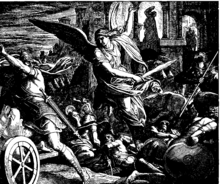2 Kings 19
[8][9] The whole narrative is presented in a parallel structure:[10] This section records the response of king Hezekiah and prophet Isaiah to the speeches of Rabshakeh in the previous chapter.
The answer from Isaiah is the classic opening, 'Do not be afraid', followed by a positive oracle that YHWH will send a 'spirit' to the Assyrian king (cf.
In his annals (ANET 287[11]), the Assyrian king also mentions the advance of an Egyptian army, though he claims to have defeated them at Eltekeh, near the border of Philistine and Egypt (cf.
[18] The Assyrians were still in Syria-Palestine, and even after hearing a report of Taharqa's attack, Sennacherib became bolder than Rabshakeh in mocking YHWH to be at the same level as the useless gods of other defeated nations.
[23] The second response from Isaiah is much more detailed than his first, containing three oracles in Isaiah's message this time:[24] The speech has an ABCBA structure, bracketed by an introductory and a concluding formula ('thus says the LORD—says the LORD'), containing a central message with a double assurance that the enemy shall not enter this city: his weapons will not harm Jerusalem and he shall retreat in failure.
"Historiographically, his reign is noteworthy for the convergence of a variety of biblical sources and diverse extrabiblical evidence often bearing on the same events.
Significant data concerning Hezekiah appear in the Deuteronomistic History, the Chronicler, Isaiah, Assyrian annals and reliefs, Israelite epigraphy, and, increasingly, stratigraphy".
[45] Archaeologist Amihai Mazar calls the tensions between Assyria and Judah "one of the best-documented events of the Iron Age" and Hezekiah's story is one of the best to cross-reference with the rest of the Mid Eastern world's historical documents.
[53][54][55] The accounts of Sennacherib of Assyria, including his invasion into the Kingdom of Judah, especially the capture of Lachish and the siege of Jerusalem, are recorded in a number of ancient documents and artifacts:[56]







